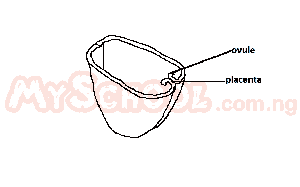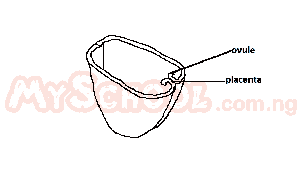The depth of illumination in a water body can be measured with a
- A. photometer
- B. secchi disc
- C. hydrometer
- D. anemometer
Which of the following ions is involved in the conduction of the nerve impulse?
- A. Ca2+
- B. K+
- C. H+
- D. Mg2+
The gland directly affecting metabolic rate, growth and development is known as
- A. adrenal land
- B. thyroid gland
- C. mammary gland
- D. parathyroid gland
The process of walking is under the control of the part of the brain called
- A. optic lobe
- B. olfactory lobe
- C. cerebellum
- D. medulla oblongata
Biological growth refers strictly to an increase in the
- A. protoplasm of an organism
- B. number of organisms
- C. size of an organism
- D. development of form
The sex of a foetus is determined during
- A. meiosis
- B. copulation
- C. fertilization
- D. placentation
The term caryopsis is used to describe a fruit in which the
- A. testa and pericarp are separate
- B. seed and endocarp are fused
- C. testa and pericarp are fused
- D. seed coat and fruit wall are impermeable

An example of a plant having the placentation shown is
- A. allamander
- B. hibiscus
- C. water lily
- D. pride of Barbados

The type of placentaion shown is
- A. axial
- B. marginal
- C. parietal
- D. central
When a healthy shoot of a flowering plant is illuminated from one side, auxins, accumulate on the
- A. non-illuminated side of the shoot
- B. illuminated side of the shoot
- C. upper side of the shoot
- D. lower side of the shoot
During the bending of the arm, the biceps muscles
- A. contracts and the triceps muscles relaxes
- B. relaxes and the triceps muscles contracts
- C. and the triceps muscles contract
- D. and the triceps muscles relax
The excretory structure in the earthworm is the
- A. malpighian tubule
- B. flame cell
- C. nephridium
- D. kidney
During respiration, air circulates round plant tissues via the
- A. lenticels
- B. stomata
- C. guard cells
- D. intercellular spaces
The end product of glycolysis in plants and animals is
- A. pyruvic acid
- B. citric acid
- C. aspartic acid
- D. malic acid
Which of following is NOT involved in the transport of substance in the body?
- A. Lymph
- B. Plasma
- C. Leucocytes
- D. Erythrocytes
The mammalian organ which acts both as a digestive and as an endocrine organ is the
- A. oesophagus
- B. liver
- C. pancreas
- D. spleen
Which vitamin plays an important role in blood clotting?
- A. vitamin A
- B. Vitamin K
- C. Vitamin B12
- D. Vitamin C
In an experiment to investigate the effect of nitrogen on the growth of plants, the substrate should be a medium of
- A. washed sand
- B. saw dust
- C. cow dung
- D. clay soil
2H2 → 2H2 + O2(g). The equation above represents a part of the light stage of photosynthesis. Which of the following must be presents for this reaction to occur?
- A. Enzyme and light energy
- B. Carbondioxide and light energy
- C. Light energy and cholorphyll
- D. Chlorophyll and enzyme
Secondary thickening in dicotyledonous stem is controlled by the
- A. xylem
- B. phloem
- C. cambium
- D. pericycle
Birds maintain their body temperature with the help of their
- A. blood which maintains constant temperature
- B. feathers which cover the body
- C. skin which conserves moisture
- D. veins which transport fluid of constant temperature to all body tissues


